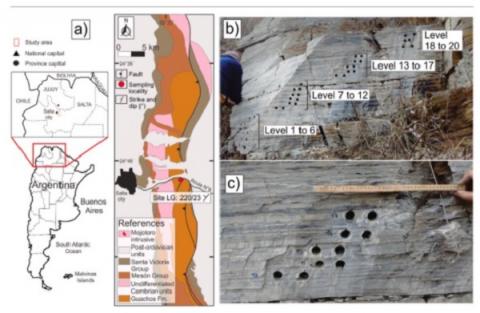Pablo R. Franceschinis, Sabrina Y. Fazzito, Augusto E. Rapalini, Mónica P. Escayola, Silvana E. Geuna, Constanza Rodríguez Piceda
2 021
Journal of South American Earth Sciences Volume 106, March 2021, 102887
The Permian remagnetization belt that affects the southwestern margin of Gondwana has an important geographic extension reaching several South American cratons and terranes. A paleomagnetic pole for the Early Cambrian Guachos Formation in the Eastern Cordillera of Argentina was computed (LG: Lat: 58.1°S, Long: 20.2°E, A95: 6.4°, n: 30), that likely corresponds to a Permian remagnetization and suggests that such belt might extend further north than previously envisaged. We performed several rock-magnetic studies on this succession of laminated fine grain sandstones and siltstones in order to determine the magnetic phases that carry the remanence. Thermomagnetic (k vs. T) curves, field and frequency dependence of bulk susceptibility, hysteresis loops, isothermal remanent magnetization acquisition and back-field curves, three-axis IRM thermal demagnetization, among others, permitted to establish magnetite as the main mineral carrying the remanence. Microscopic observations confirmed a secondary chemical origin for magnetite. Magnetic fabric studies indicate a tectonic fabric, consistent with cleavage developed on these rocks together with low-grade metamorphism. However, a Permian remagnetization, as suggested by the paleomagnetic pole position, cannot be related to Cambrian deformation and metamorphism and might be related to hydrothermal processes.

